Economics Assignment - Microeconomics and Australian Market Analysis
VerifiedAdded on 2022/10/01
|11
|1030
|213
Homework Assignment
AI Summary
This economics assignment delves into microeconomic principles, starting with Joan's production possibilities and the concept of opportunity cost, illustrated through tables and graphs. It then explores market dynamics, including equilibrium price and quantity shifts in solar and conventional vehicle markets, and analyzes the impact of minimum price policies. The assignment further examines price elasticity of demand in different contexts, such as ice cream in various seasons and cigarette consumption. It addresses firm behavior, including loss minimization and profit maximization, and concludes with an analysis of the Australian banking market, highlighting its characteristics as a concentrated industry similar to a monopoly. The assignment utilizes graphs and explanations to clarify economic concepts and includes a list of relevant references.
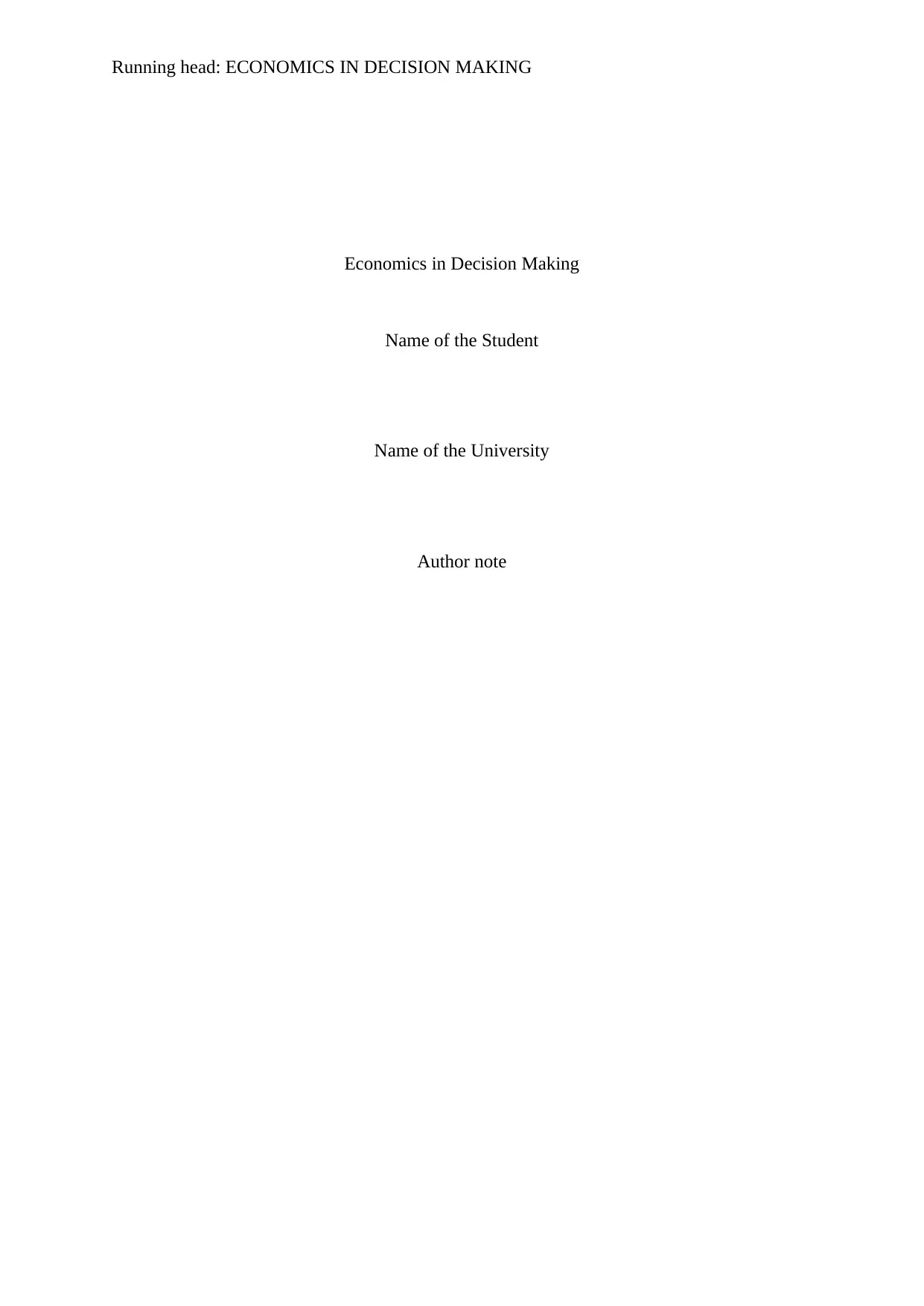
Running head: ECONOMICS IN DECISION MAKING
Economics in Decision Making
Name of the Student
Name of the University
Author note
Economics in Decision Making
Name of the Student
Name of the University
Author note
Paraphrase This Document
Need a fresh take? Get an instant paraphrase of this document with our AI Paraphraser
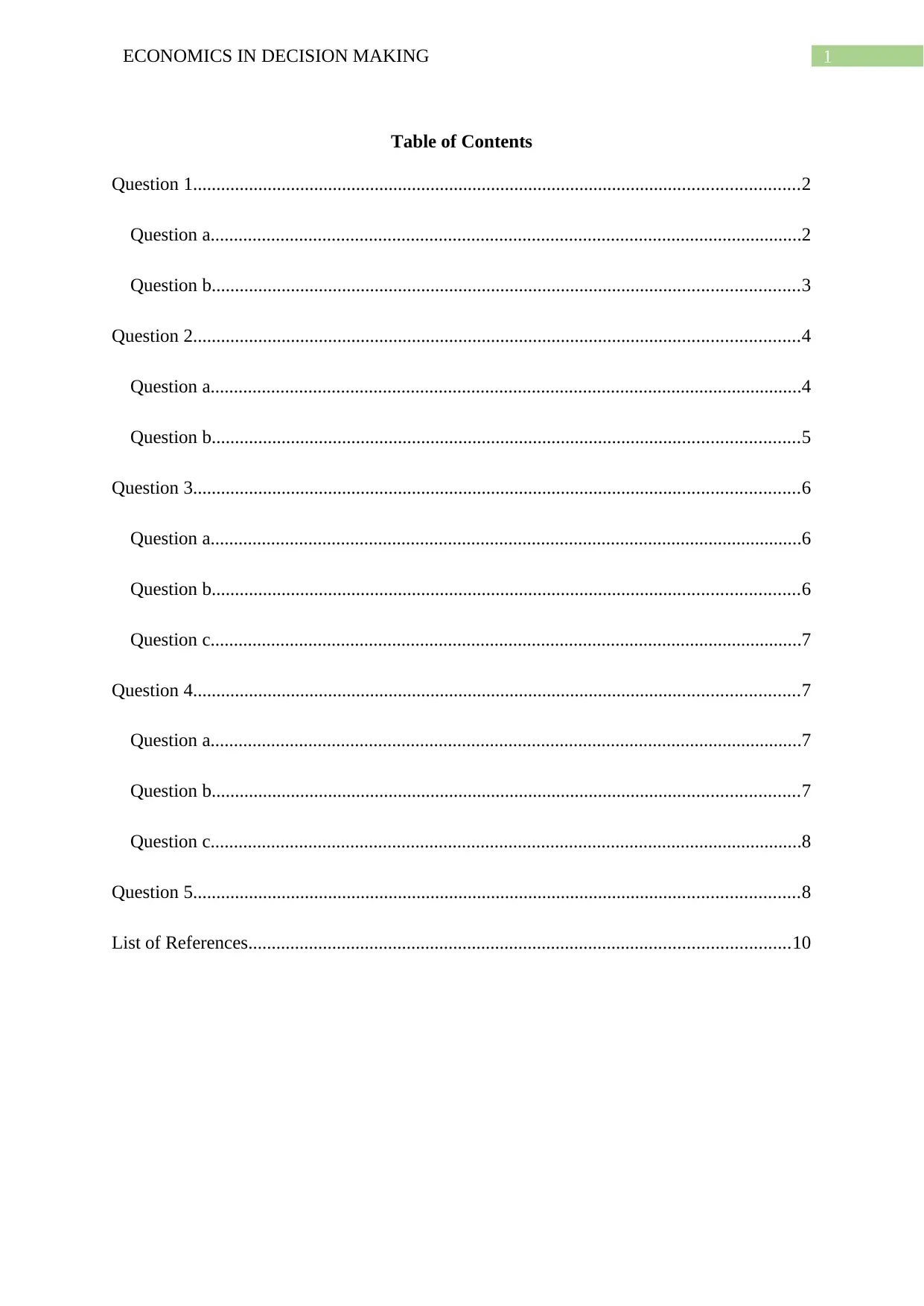
1ECONOMICS IN DECISION MAKING
Table of Contents
Question 1..................................................................................................................................2
Question a...............................................................................................................................2
Question b..............................................................................................................................3
Question 2..................................................................................................................................4
Question a...............................................................................................................................4
Question b..............................................................................................................................5
Question 3..................................................................................................................................6
Question a...............................................................................................................................6
Question b..............................................................................................................................6
Question c...............................................................................................................................7
Question 4..................................................................................................................................7
Question a...............................................................................................................................7
Question b..............................................................................................................................7
Question c...............................................................................................................................8
Question 5..................................................................................................................................8
List of References....................................................................................................................10
Table of Contents
Question 1..................................................................................................................................2
Question a...............................................................................................................................2
Question b..............................................................................................................................3
Question 2..................................................................................................................................4
Question a...............................................................................................................................4
Question b..............................................................................................................................5
Question 3..................................................................................................................................6
Question a...............................................................................................................................6
Question b..............................................................................................................................6
Question c...............................................................................................................................7
Question 4..................................................................................................................................7
Question a...............................................................................................................................7
Question b..............................................................................................................................7
Question c...............................................................................................................................8
Question 5..................................................................................................................................8
List of References....................................................................................................................10
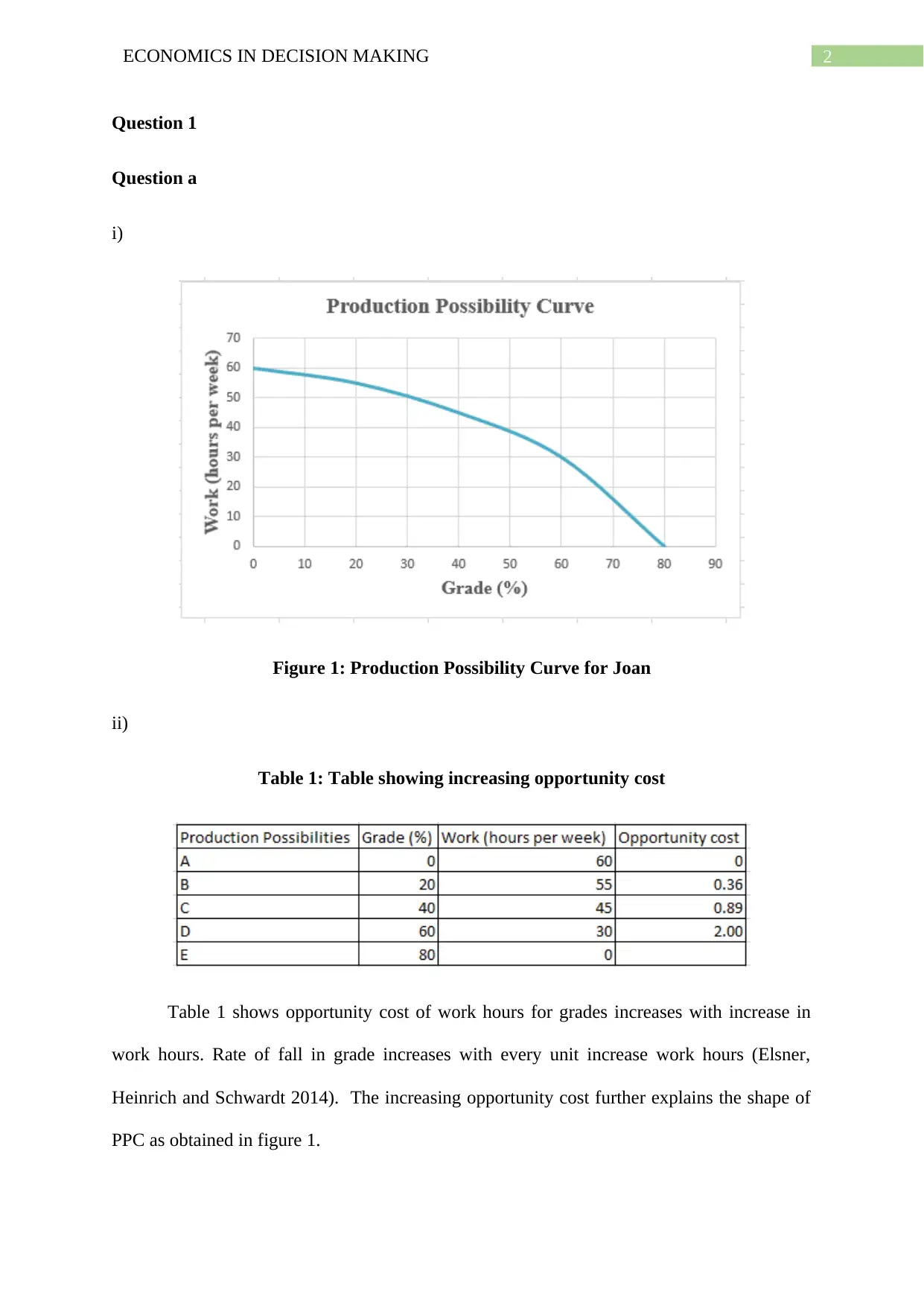
2ECONOMICS IN DECISION MAKING
Question 1
Question a
i)
Figure 1: Production Possibility Curve for Joan
ii)
Table 1: Table showing increasing opportunity cost
Table 1 shows opportunity cost of work hours for grades increases with increase in
work hours. Rate of fall in grade increases with every unit increase work hours (Elsner,
Heinrich and Schwardt 2014). The increasing opportunity cost further explains the shape of
PPC as obtained in figure 1.
Question 1
Question a
i)
Figure 1: Production Possibility Curve for Joan
ii)
Table 1: Table showing increasing opportunity cost
Table 1 shows opportunity cost of work hours for grades increases with increase in
work hours. Rate of fall in grade increases with every unit increase work hours (Elsner,
Heinrich and Schwardt 2014). The increasing opportunity cost further explains the shape of
PPC as obtained in figure 1.
⊘ This is a preview!⊘
Do you want full access?
Subscribe today to unlock all pages.

Trusted by 1+ million students worldwide

3ECONOMICS IN DECISION MAKING
iii)
In case constant opportunity cost of Joan, production possibility curve is obtained as a
straight line. Of the two shapes of PPC, the one obtained in figure 1 is more likely to occur
because opportunity cost generally increases with unit increase in goods rather than remain
constant with every unit of production.
Figure 2: Joan’s production possibility curve with constant opportunity cost
iv)
Joan is allocating her resources inefficiently in case combination of work hours and grade
below the frontier.
v)
Joan can push the optimal combination outside the current curve by raising her efficiency in
obtaining more grades along with increasing work hours.
Question b
People in the economy face scarcity problem because of unlimited wants and limited
resources. With sufficient amount of money people also face scarcity problem due their
iii)
In case constant opportunity cost of Joan, production possibility curve is obtained as a
straight line. Of the two shapes of PPC, the one obtained in figure 1 is more likely to occur
because opportunity cost generally increases with unit increase in goods rather than remain
constant with every unit of production.
Figure 2: Joan’s production possibility curve with constant opportunity cost
iv)
Joan is allocating her resources inefficiently in case combination of work hours and grade
below the frontier.
v)
Joan can push the optimal combination outside the current curve by raising her efficiency in
obtaining more grades along with increasing work hours.
Question b
People in the economy face scarcity problem because of unlimited wants and limited
resources. With sufficient amount of money people also face scarcity problem due their
Paraphrase This Document
Need a fresh take? Get an instant paraphrase of this document with our AI Paraphraser
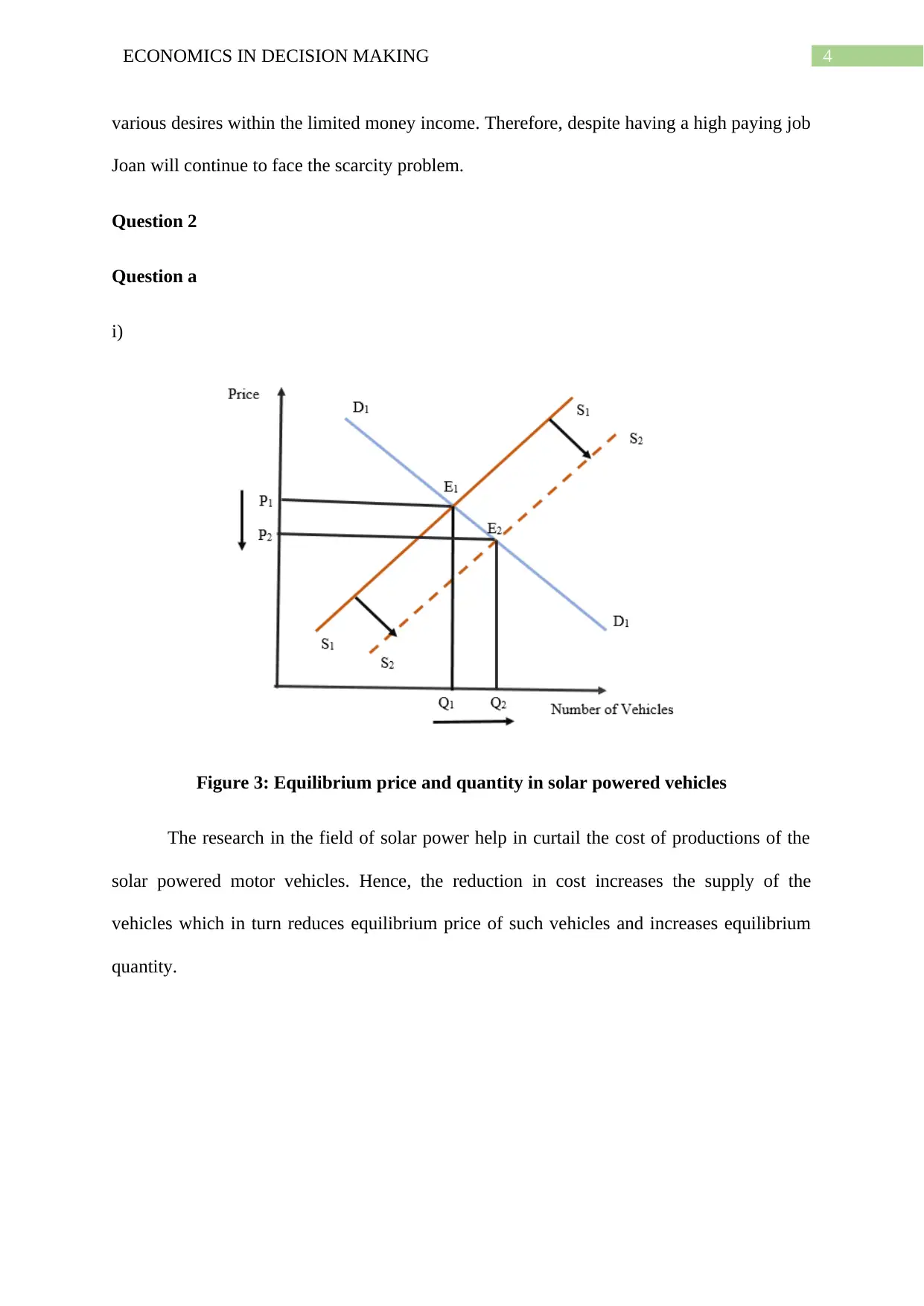
4ECONOMICS IN DECISION MAKING
various desires within the limited money income. Therefore, despite having a high paying job
Joan will continue to face the scarcity problem.
Question 2
Question a
i)
Figure 3: Equilibrium price and quantity in solar powered vehicles
The research in the field of solar power help in curtail the cost of productions of the
solar powered motor vehicles. Hence, the reduction in cost increases the supply of the
vehicles which in turn reduces equilibrium price of such vehicles and increases equilibrium
quantity.
various desires within the limited money income. Therefore, despite having a high paying job
Joan will continue to face the scarcity problem.
Question 2
Question a
i)
Figure 3: Equilibrium price and quantity in solar powered vehicles
The research in the field of solar power help in curtail the cost of productions of the
solar powered motor vehicles. Hence, the reduction in cost increases the supply of the
vehicles which in turn reduces equilibrium price of such vehicles and increases equilibrium
quantity.
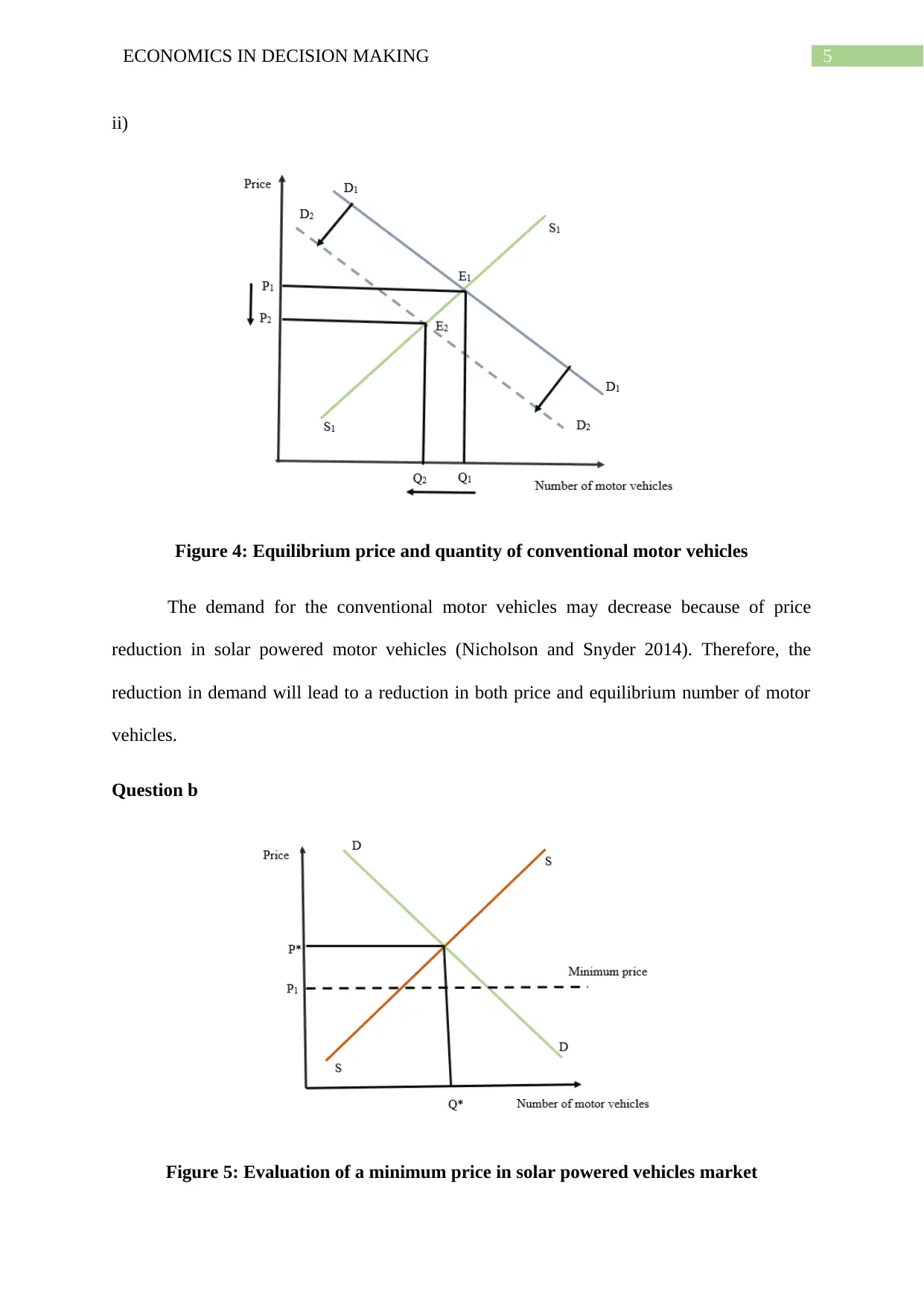
5ECONOMICS IN DECISION MAKING
ii)
Figure 4: Equilibrium price and quantity of conventional motor vehicles
The demand for the conventional motor vehicles may decrease because of price
reduction in solar powered motor vehicles (Nicholson and Snyder 2014). Therefore, the
reduction in demand will lead to a reduction in both price and equilibrium number of motor
vehicles.
Question b
Figure 5: Evaluation of a minimum price in solar powered vehicles market
ii)
Figure 4: Equilibrium price and quantity of conventional motor vehicles
The demand for the conventional motor vehicles may decrease because of price
reduction in solar powered motor vehicles (Nicholson and Snyder 2014). Therefore, the
reduction in demand will lead to a reduction in both price and equilibrium number of motor
vehicles.
Question b
Figure 5: Evaluation of a minimum price in solar powered vehicles market
⊘ This is a preview!⊘
Do you want full access?
Subscribe today to unlock all pages.

Trusted by 1+ million students worldwide
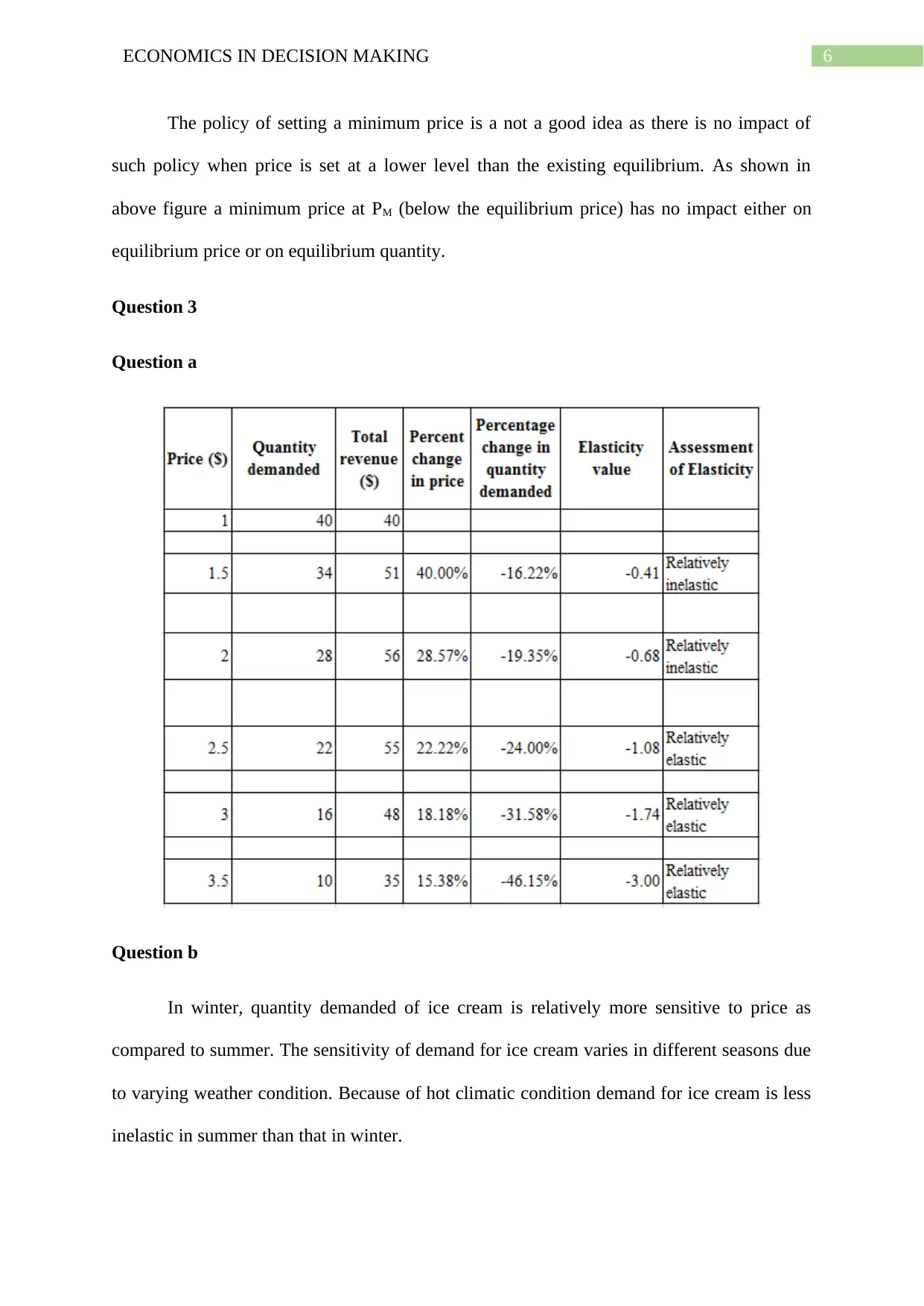
6ECONOMICS IN DECISION MAKING
The policy of setting a minimum price is a not a good idea as there is no impact of
such policy when price is set at a lower level than the existing equilibrium. As shown in
above figure a minimum price at PM (below the equilibrium price) has no impact either on
equilibrium price or on equilibrium quantity.
Question 3
Question a
Question b
In winter, quantity demanded of ice cream is relatively more sensitive to price as
compared to summer. The sensitivity of demand for ice cream varies in different seasons due
to varying weather condition. Because of hot climatic condition demand for ice cream is less
inelastic in summer than that in winter.
The policy of setting a minimum price is a not a good idea as there is no impact of
such policy when price is set at a lower level than the existing equilibrium. As shown in
above figure a minimum price at PM (below the equilibrium price) has no impact either on
equilibrium price or on equilibrium quantity.
Question 3
Question a
Question b
In winter, quantity demanded of ice cream is relatively more sensitive to price as
compared to summer. The sensitivity of demand for ice cream varies in different seasons due
to varying weather condition. Because of hot climatic condition demand for ice cream is less
inelastic in summer than that in winter.
Paraphrase This Document
Need a fresh take? Get an instant paraphrase of this document with our AI Paraphraser
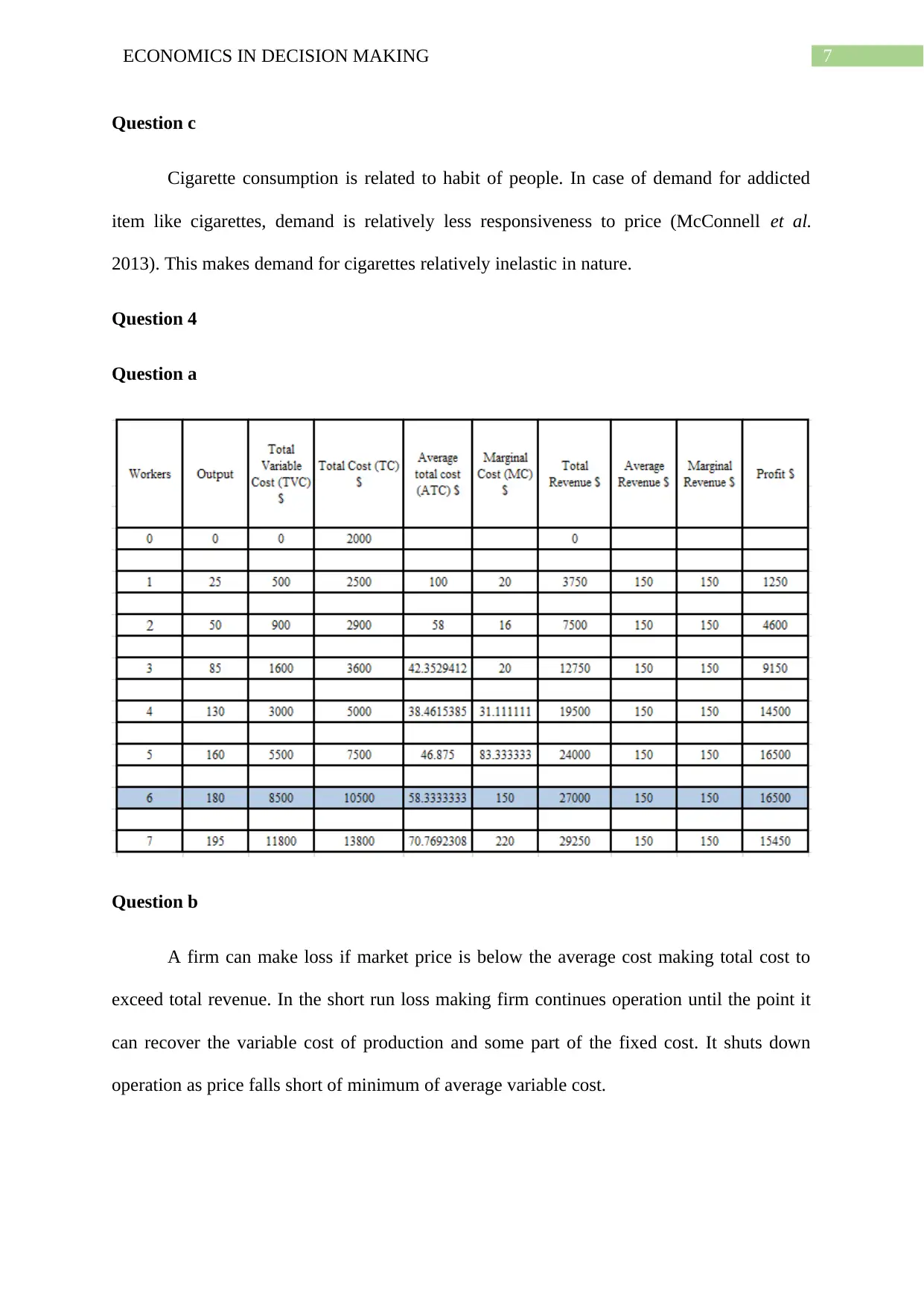
7ECONOMICS IN DECISION MAKING
Question c
Cigarette consumption is related to habit of people. In case of demand for addicted
item like cigarettes, demand is relatively less responsiveness to price (McConnell et al.
2013). This makes demand for cigarettes relatively inelastic in nature.
Question 4
Question a
Question b
A firm can make loss if market price is below the average cost making total cost to
exceed total revenue. In the short run loss making firm continues operation until the point it
can recover the variable cost of production and some part of the fixed cost. It shuts down
operation as price falls short of minimum of average variable cost.
Question c
Cigarette consumption is related to habit of people. In case of demand for addicted
item like cigarettes, demand is relatively less responsiveness to price (McConnell et al.
2013). This makes demand for cigarettes relatively inelastic in nature.
Question 4
Question a
Question b
A firm can make loss if market price is below the average cost making total cost to
exceed total revenue. In the short run loss making firm continues operation until the point it
can recover the variable cost of production and some part of the fixed cost. It shuts down
operation as price falls short of minimum of average variable cost.
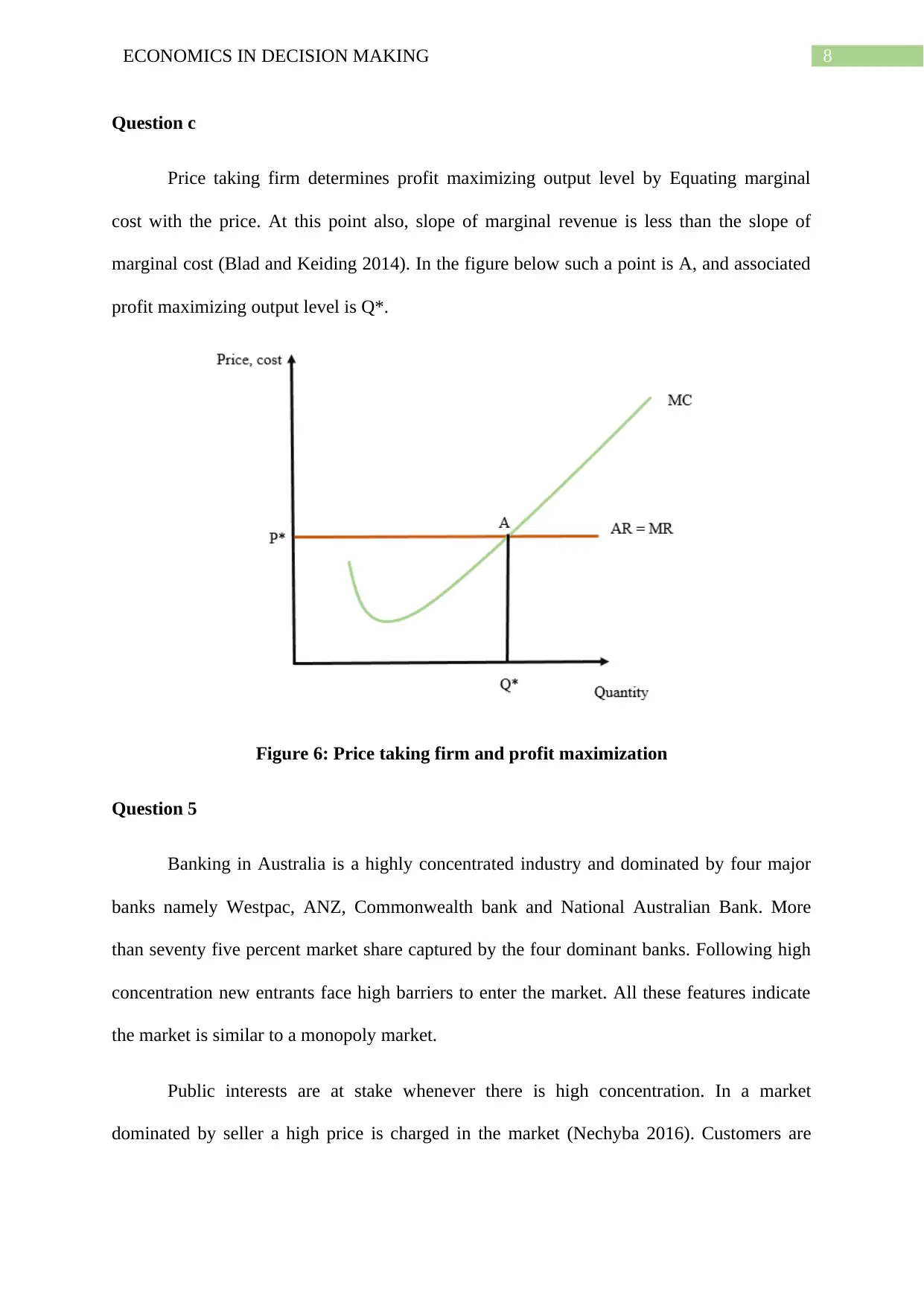
8ECONOMICS IN DECISION MAKING
Question c
Price taking firm determines profit maximizing output level by Equating marginal
cost with the price. At this point also, slope of marginal revenue is less than the slope of
marginal cost (Blad and Keiding 2014). In the figure below such a point is A, and associated
profit maximizing output level is Q*.
Figure 6: Price taking firm and profit maximization
Question 5
Banking in Australia is a highly concentrated industry and dominated by four major
banks namely Westpac, ANZ, Commonwealth bank and National Australian Bank. More
than seventy five percent market share captured by the four dominant banks. Following high
concentration new entrants face high barriers to enter the market. All these features indicate
the market is similar to a monopoly market.
Public interests are at stake whenever there is high concentration. In a market
dominated by seller a high price is charged in the market (Nechyba 2016). Customers are
Question c
Price taking firm determines profit maximizing output level by Equating marginal
cost with the price. At this point also, slope of marginal revenue is less than the slope of
marginal cost (Blad and Keiding 2014). In the figure below such a point is A, and associated
profit maximizing output level is Q*.
Figure 6: Price taking firm and profit maximization
Question 5
Banking in Australia is a highly concentrated industry and dominated by four major
banks namely Westpac, ANZ, Commonwealth bank and National Australian Bank. More
than seventy five percent market share captured by the four dominant banks. Following high
concentration new entrants face high barriers to enter the market. All these features indicate
the market is similar to a monopoly market.
Public interests are at stake whenever there is high concentration. In a market
dominated by seller a high price is charged in the market (Nechyba 2016). Customers are
⊘ This is a preview!⊘
Do you want full access?
Subscribe today to unlock all pages.

Trusted by 1+ million students worldwide
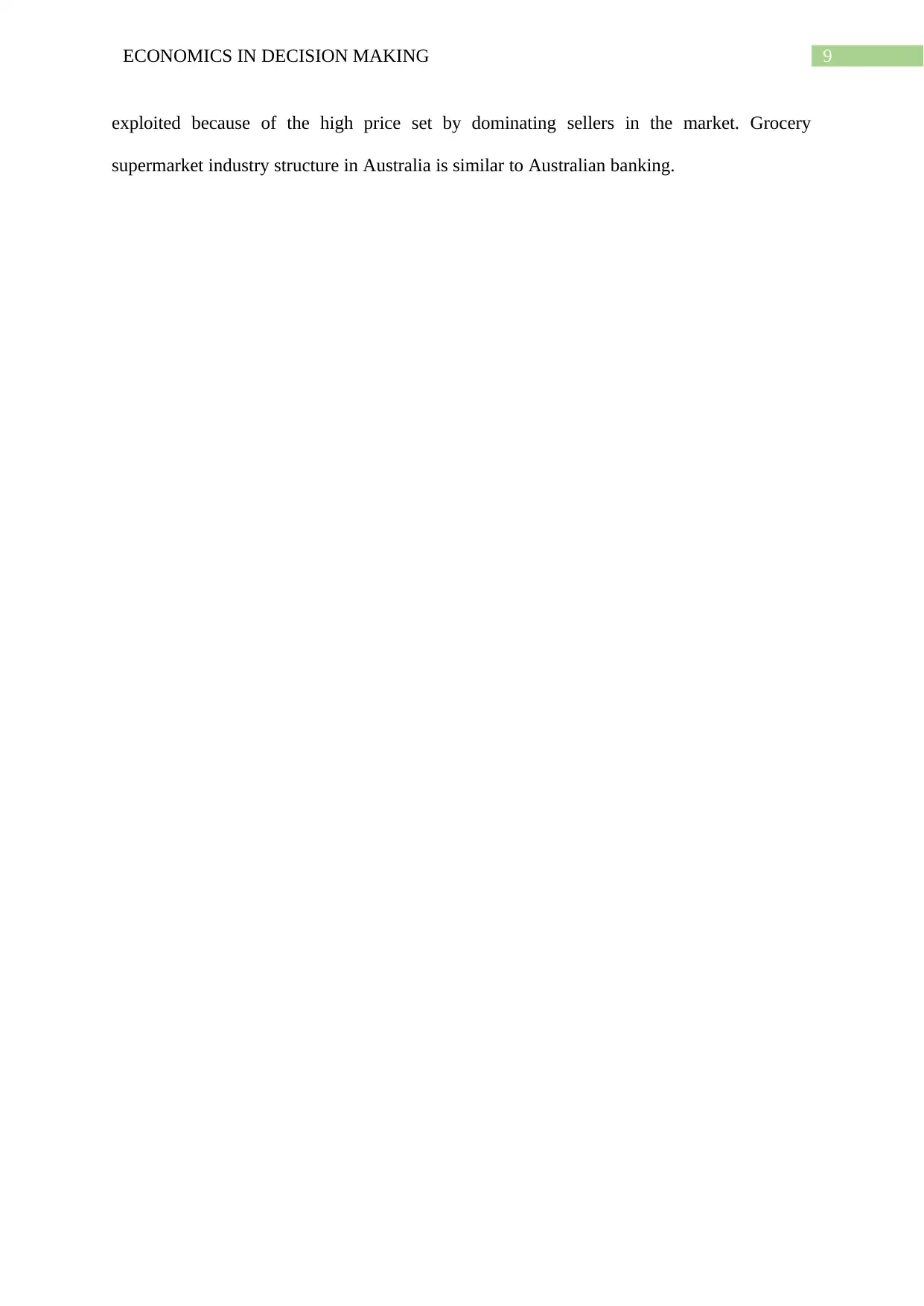
9ECONOMICS IN DECISION MAKING
exploited because of the high price set by dominating sellers in the market. Grocery
supermarket industry structure in Australia is similar to Australian banking.
exploited because of the high price set by dominating sellers in the market. Grocery
supermarket industry structure in Australia is similar to Australian banking.
Paraphrase This Document
Need a fresh take? Get an instant paraphrase of this document with our AI Paraphraser
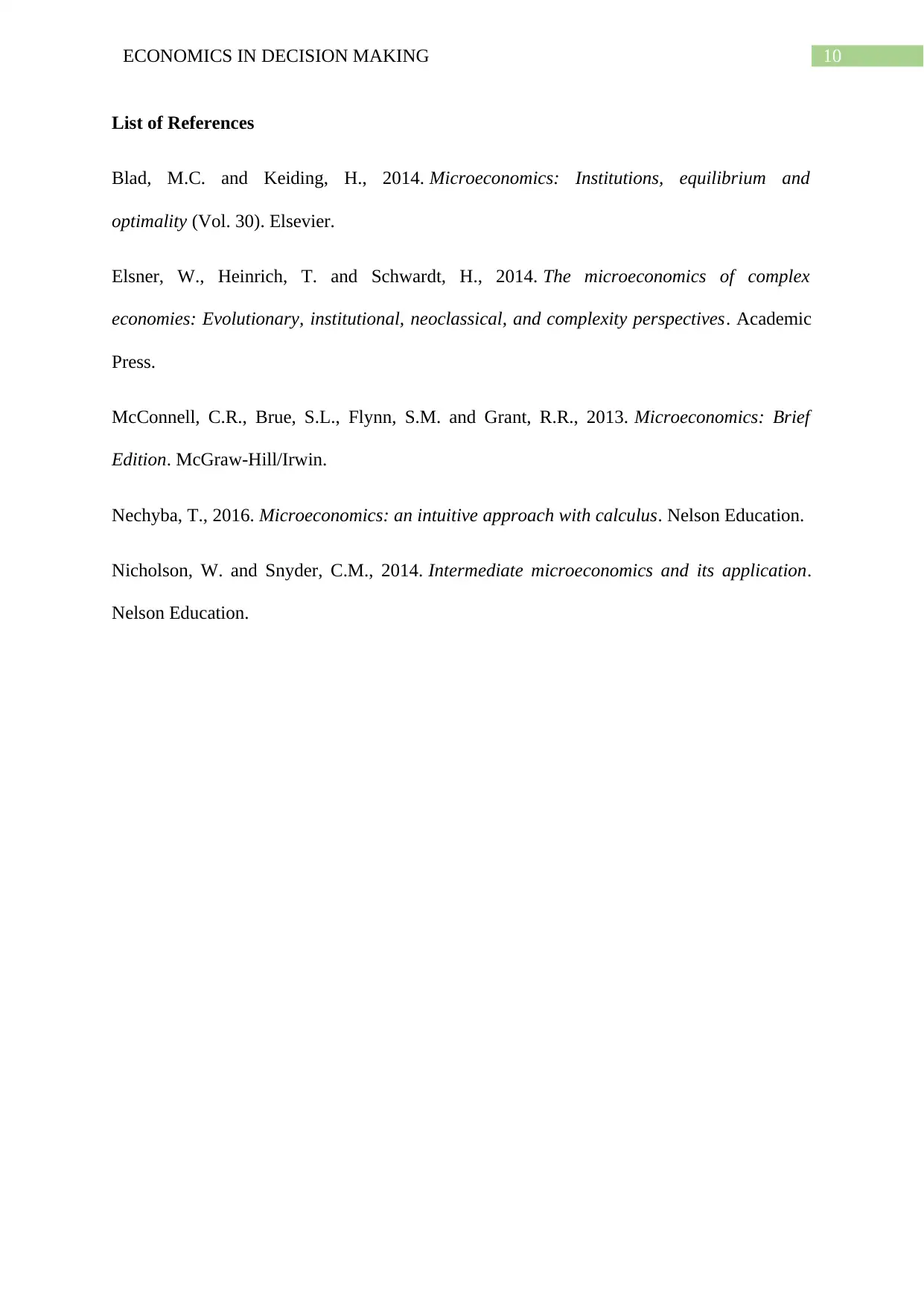
10ECONOMICS IN DECISION MAKING
List of References
Blad, M.C. and Keiding, H., 2014. Microeconomics: Institutions, equilibrium and
optimality (Vol. 30). Elsevier.
Elsner, W., Heinrich, T. and Schwardt, H., 2014. The microeconomics of complex
economies: Evolutionary, institutional, neoclassical, and complexity perspectives. Academic
Press.
McConnell, C.R., Brue, S.L., Flynn, S.M. and Grant, R.R., 2013. Microeconomics: Brief
Edition. McGraw-Hill/Irwin.
Nechyba, T., 2016. Microeconomics: an intuitive approach with calculus. Nelson Education.
Nicholson, W. and Snyder, C.M., 2014. Intermediate microeconomics and its application.
Nelson Education.
List of References
Blad, M.C. and Keiding, H., 2014. Microeconomics: Institutions, equilibrium and
optimality (Vol. 30). Elsevier.
Elsner, W., Heinrich, T. and Schwardt, H., 2014. The microeconomics of complex
economies: Evolutionary, institutional, neoclassical, and complexity perspectives. Academic
Press.
McConnell, C.R., Brue, S.L., Flynn, S.M. and Grant, R.R., 2013. Microeconomics: Brief
Edition. McGraw-Hill/Irwin.
Nechyba, T., 2016. Microeconomics: an intuitive approach with calculus. Nelson Education.
Nicholson, W. and Snyder, C.M., 2014. Intermediate microeconomics and its application.
Nelson Education.
1 out of 11
Related Documents
Your All-in-One AI-Powered Toolkit for Academic Success.
+13062052269
info@desklib.com
Available 24*7 on WhatsApp / Email
![[object Object]](/_next/static/media/star-bottom.7253800d.svg)
Unlock your academic potential
Copyright © 2020–2025 A2Z Services. All Rights Reserved. Developed and managed by ZUCOL.





